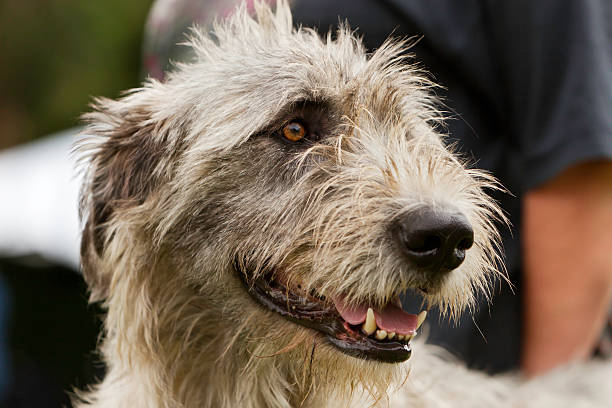Among the breeds popularly referred to today as wolfhounds, there are two dog breeds that were actually created through hybrid crosses between the closely related animal species, thereby regaining their wild side. That sounds more romantic than it is in practice: You can find out here what challenges you face as the owner of Czechoslovakian wolfhounds and Saarloos wolfhounds.
Wolfhound Appearance: Confusingly Similar
Both wolfhound breeds are almost indistinguishable from the true European wolf to the untrained eye. They are slightly smaller and slimmer than their wild counterparts, and their face is generally rounder with softer features. The fur also has a different structure and appears shinier and finer overall. Carlos wolfhounds come in different colorings, Czechoslovakian wolfhounds only come in one uniform coloring. Both breeds are recognized by the FCI and are bred according to uniform standards.
Real and fake wolfhounds

In addition to the two true European wolfhound breeds, there are individual breeding lines of dogs with a high genetic wolf proportion and those that only have the term “wolfhound” in their name:
- The American wolfhound is widespread in the USA and was created from crosses between Timberwolf, Alaskan Malamute, Siberian and Alaskan Huskies. The animals are more long-legged and overall slightly larger than Czechoslovakian wolfhounds.
- The borzoi (Russian wolfhound) and Irish wolfhound bear the name only, but they are sighthounds and are no more closely related to wolves than other sighthound breeds.
- Since 2004, individual German breeders have been breeding the first litters of the purebred Marxdorfer wolfhound, which is built somewhat narrower than its role models from the Czech Republic and the Netherlands.
Breed standards for wolf dogs
- FCI Breed Standard for Czechoslovakian Wolfhounds.
- FCI Breed Standard for Saarloos Wolfhounds.
- The breed standard of the first breeder for Marxdorfer Wolfhounds.
- There is no single breed standard for American wolfhounds.
External Characteristics of the Wolf Dogs: More Dogs than Wolf
- The head is significantly narrower and the jawless pronounced than that of the wolf. The Czechoslovakian wolfhound shows a closer connection to the wild animals; Saarloos Wolfhounds have more German shepherd dogs.
- Typical for wolves, the V-shaped ears are set high up and can be adjusted at an angle of almost 180 degrees. In a relaxed posture, they point forward.
- Amber eyes are considered to be the most distinctive distinguishing feature of true wolfhounds.
- Both dog breeds have a minimum size of 60 centimeters for females and 65 centimeters for males. They can reach a height at the withers of up to 75 centimeters and more. The dogs are very agile and strong, but significantly slimmer and lighter than dogs of comparable size.
- The dogs move at a graceful trot or amble. They have long toes with strong claws on their paws.
- The tail of the Czechoslovakian wolfhound sets high, while that of the Saarloos wolfhound is noticeably low. It reaches at least to the hock and is usually carried hanging down. When excited, the tail curves upwards in a crescent shape.
Colors and markings: Original and wild
- The base color of Czechoslovakian wolfhounds is more yellow-grey in winter, in summer they lose their thick undercoat and the top coat appears silver-grey with yellow wolf markings.
- The ground color in Saarloos Wolfhounds is black-shaded or brown-shaded. The wolf markings are creamy-white or white.
- Wolfhounds do not wear pure coat colors like other dog breeds, but rather darkly shaded wild colors, similar to hares, wild boars, and badgers.
- Wolf markings are typical bright spots on the inside of the legs and on the stomach. These are not clearly demarcated, but usually merge into the basic color on the sides and back via yellow-grey and silver-grey shades.
- Solid black, blue-gray, cream or white coat coloring is unique to American wolfhounds.
History and Origin of the Wolf-Dog: Service Dog or Companion Dog?
The two recognized wolfhound breeds have different lineages and were bred for different purposes. A common relative is a German shepherd. That being said, the two breeds have less in common than you might think:
The History of the Czechoslovakian Wolfhound
- In the 1950s, the Czechoslovak border guard tried to breed service dogs that had the strength and endurance of wolves. Carpathian wolves in captivity were mated with German shepherd dogs.
- The newly created dog breed was stubborn, shy, and generally unsuitable for the task of service dogs.
- According to rumors, the crossing initially failed, until a particularly aggressive and dangerous shepherd dog accidentally entered the enclosure of a breeding wolf and successfully covered her. Irrespective of this incident, the disordered German Shepherd had to be shot years later because he had seriously injured his owner.
- The Czechoslovakian wolfhounds are probably more devious and aggressive than the Saarloos wolfhounds because of their origin history and their closer relationship to the wolf.
The History of the Saarloos Wolfhound

- The Saarloos Wolfhound is slightly older than the Czechoslovakian type. The breed originated in the Netherlands from crosses between German shepherds and Siberian timberwolves.
- The first offspring of the breed in the early 1930s were still used successfully as guide dogs.
- Further introgressions of wolves made the breed too shy and unconventional for training as a service dog.
- Today, the Saarloos Wolfhound, named after its first breeder, is a popular companion and family dog for nature-loving and active owners.
Nature and Character of the Wolf-Dog Breeds
Opinions on the character of the wolf-dog breeds vary widely: weekly newspapers and the German media criticize the breeding and keeping of the “dangerous” dogs with wolf parts, while breeders and fans of the breed affirm their suitability for families and value them for their unconditional loyalty. How much wolf there is in the dog depends on the breeding line and the experiences of the puppies during the imprinting and socialization phase.